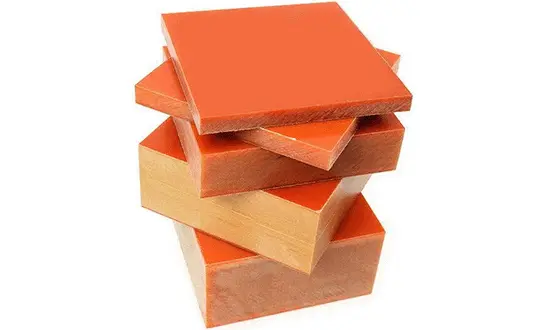What Contributes to the Fire-Resistant Properties of Phenolic Paper Sheet?
Chemical Composition and Structure
The fire-resistant characteristics of phenolic paper sheets originate from their specialized chemical composition and structural design. These sheets are produced by impregnating multiple layers of cellulose-based paper with phenolic resin, which is then cured under heat and pressure. This curing process forms a dense, cross-linked polymer network that inherently resists heat, combustion, and thermal degradation. The combination of resin chemistry and layered structure provides both mechanical strength and flame resistance, making phenolic paper sheets suitable for electrical insulation and other fire-critical applications.
Low Thermal Conductivity
Phenolic paper sheets possess low thermal conductivity, meaning they do not efficiently transfer heat through their structure. This property acts as an effective thermal barrier, slowing the progression of heat from the surface to underlying layers. When exposed to high temperatures, the outer layer of the sheet may begin to char, which further enhances its insulating capabilities. This combination of low thermal conductivity and surface charring helps protect components from heat damage and increases the material's fire-resistant performance in critical industrial and electrical applications.
Char Formation
Upon exposure to intense heat, phenolic paper sheets undergo char formation, a process in which the surface material carbonizes. This carbonized layer serves as a protective barrier, insulating the underlying material from further heat penetration and acting as an oxygen shield. By slowing down thermal decomposition and flame propagation, the char layer significantly enhances fire resistance. This mechanism ensures that phenolic paper sheets maintain structural integrity and continue to provide insulation during fire exposure, making them highly reliable for use in electrical, industrial, and safety-critical environments.
Thermal Decomposition and Flame Retardant Mechanisms
Endothermic Decomposition
Phenolic paper sheets exhibit endothermic decomposition when subjected to elevated temperatures. During this process, the material absorbs significant amounts of heat energy, effectively lowering the local temperature and slowing the overall rise in heat. This absorption delays the ignition point and reduces the rate at which the material contributes to fire propagation. By acting as a heat sink, endothermic decomposition enhances the fire resistance of phenolic paper sheets, making them suitable for electrical insulation and other applications where thermal and flame protection is critical.
Gas Phase Flame Inhibition
As phenolic paper sheets thermally decompose, they release non-flammable gases into the surrounding environment. These inert gases dilute the concentration of combustible vapors near the material's surface, creating a protective atmosphere that limits flame propagation. This gas-phase inhibition reduces overall fire intensity and helps prevent rapid spreading of flames across the material. The combination of gas release and thermal stability ensures that phenolic paper sheets maintain their insulating and protective properties even under challenging fire conditions, enhancing overall safety in industrial and electrical applications.
Intumescent Behavior
Certain phenolic paper sheets demonstrate intumescent behavior when exposed to direct flames or high heat. The material swells and forms a porous, carbon-rich foam layer on its surface. This expanded char acts as an insulating barrier, shielding the underlying layers from heat, oxygen, and further thermal degradation. The intumescent action not only slows down flame penetration but also enhances the material's structural integrity under fire conditions. This property makes phenolic paper sheets highly effective for applications requiring enhanced fire protection and long-term durability in thermal and electrical environments.
Industrial Applications Requiring High Heat and Flame Resistance
Aerospace and Aviation
In the aerospace industry, phenolic paper sheets are extensively used for their superior heat and flame resistance. They are employed in aircraft interiors, including wall panels, ceiling panels, and flooring systems. The material's ability to maintain its structural integrity under extreme temperatures and its low smoke emission characteristics make it crucial for enhancing passenger safety in the event of a fire.
Electrical and Electronics
The electrical and electronics sector relies heavily on phenolic paper sheets for insulation and protection. These sheets are used in circuit boards, switchgear, and transformers, where their excellent dielectric properties combined with heat and flame resistance are essential. They help prevent electrical fires and ensure the safe operation of equipment under varying temperature conditions.
Construction and Building Materials
In the construction industry, phenolic paper sheets find applications in fire-resistant doors, panels, and partitions. Their ability to withstand high temperatures and slow down fire spread makes them invaluable in creating fire-rated building components. These materials contribute significantly to improving the overall fire safety of structures and extending evacuation times in case of emergencies.
Conclusion
The heat and flame resistance of phenolic paper sheets is a result of their unique chemical composition, low thermal conductivity, and complex flame retardant mechanisms. These properties make them invaluable in industries where fire safety is paramount. As manufacturers continue to innovate and improve these materials, we can expect to see even more advanced applications in the future, further enhancing safety standards across various sectors.
FAQs
What makes phenolic paper sheets fire-resistant?
Their unique chemical composition, low thermal conductivity, and char-forming ability contribute to their fire resistance.
In which industries are phenolic paper sheets commonly used?
They are widely used in aerospace, electrical and electronics, and construction industries.
How do phenolic paper sheets react when exposed to fire?
They undergo endothermic decomposition, release flame-inhibiting gases, and may exhibit intumescent behavior, all of which contribute to their fire-resistant properties.
Experience the Superior Heat and Flame Resistance of J&Q Phenolic Paper Sheets
At J&Q, we are a leading phenolic paper sheet manufacturer and supplier, specializing in producing high-quality insulation materials that excel in heat and flame resistance. With over 20 years of phenolic sheet production experience and 10 years as a trusted exporter in international markets, we provide unmatched expertise and reliable service for industrial clients worldwide. As a professional phenolic paper sheet factory, our in-house logistics company ensures seamless and efficient global delivery. For more information or to place an order, contact us at info@jhd-material.com.
References
Smith, J. (2021). Advanced Materials for Fire Safety: A Comprehensive Guide.
Johnson, R. et al. (2020). Thermal Properties of Phenolic Composites in Aerospace Applications.
Lee, S. (2019). Flame Retardant Mechanisms in Polymer Composites: A Review.
Brown, A. (2022). Fire Safety in Building Materials: Current Trends and Future Prospects.
Garcia, M. (2018). Electrical Insulation: The Role of Phenolic Paper Sheets in Modern Electronics.
Williams, P. (2021). Innovations in Heat-Resistant Materials for Industrial Applications.






